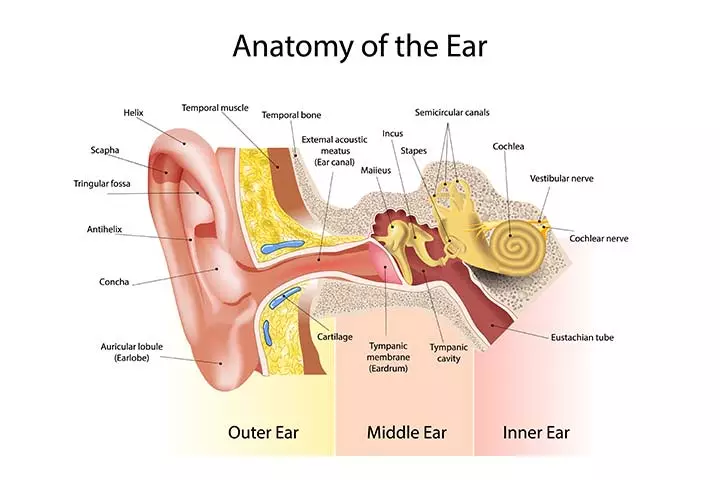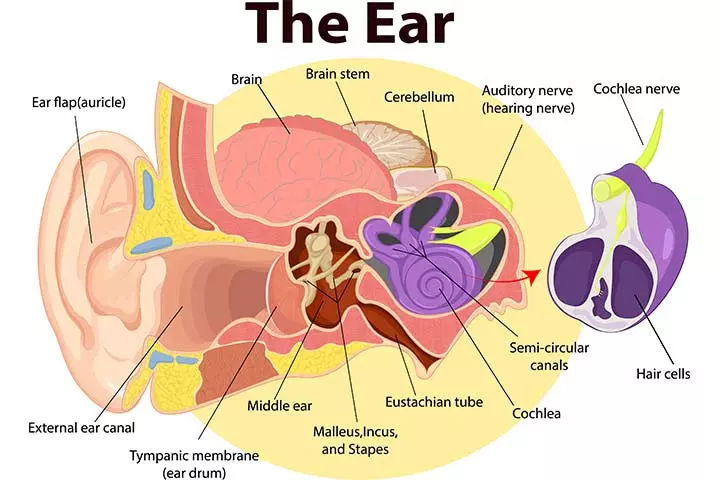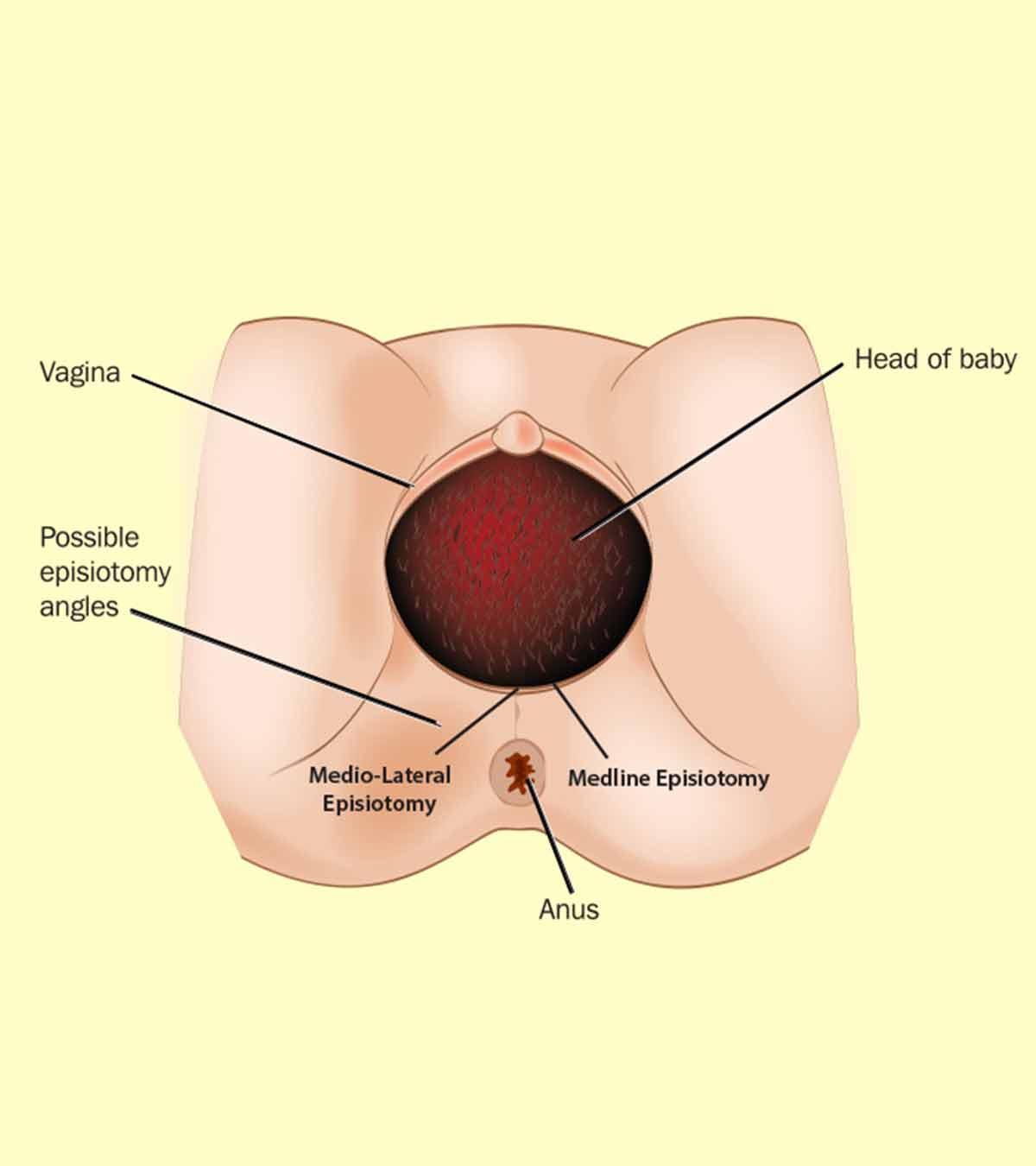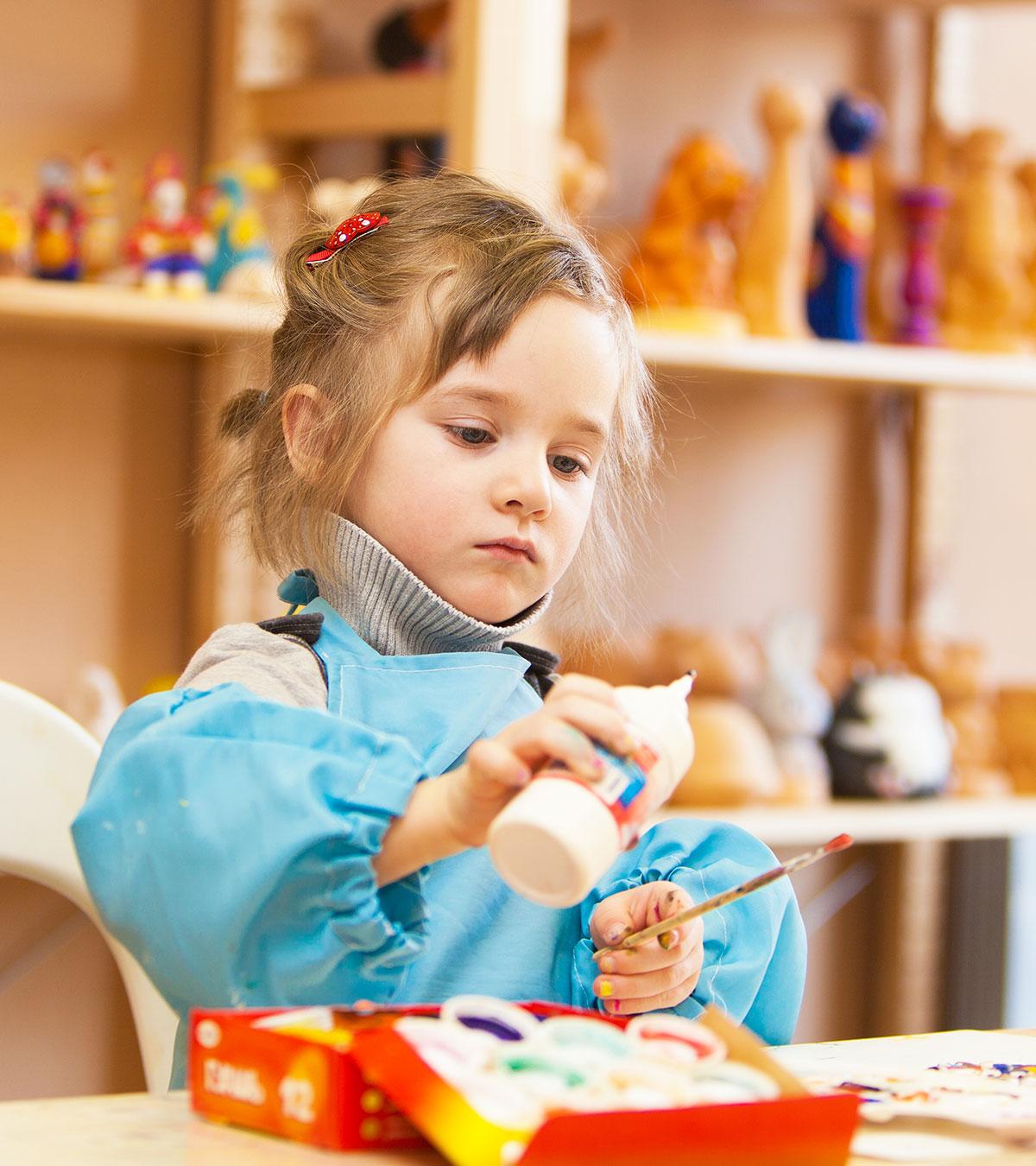
Image: Shutterstock
Learning and knowing some fun facts about the ears for kids can be interesting. Hearing (sound) is one of the five primary senses of the human body that also assists us in communicating with others.
Thanks to our hearing capabilities, we hear the honking of a car, birds chirping, family’s chitter-chatter, and various sounds from our surroundings.
Ears can be flat and round, like a frog’s, or pointy and fluffy, like a cat’s, or floppy and leathery, like an elephant’s. Continue reading this post to learn more fascinating facts about ears.
Parts Of The Ear
The ear is made up of three different sections that work together to help you hear and process sounds (1).
These three sections include:
- The outer ear
- The middle ear
- The inner ear
Image: Shutterstock
Let’s learn about each section in detail.
The outer ear
The outer ear refers to the visible part of the ear on your head. It consists of the pinna, the outer portion on either side of your head, the ear canal, and the eardrum.
The pinna acts as a funnel. It gathers sound waves and directs them into your ear canal. The ear canal is a passage leading to the middle ear.
The eardrum separates the outer ear from the middle ear. It primarily helps transmit the sound vibrations from the outer ear to the middle ear and keeps the middle ear free of dirt and bacteria.
Middle ear
The middle ear is made up of
- The ossicles. These are the three small bones, namely the malleus, the incus, and stapes, that transmit the sound waves to the inner ear.
- The eustachian tube. It connects the middle ear to the back of the throat and the back of the nasal cavity. The tube helps the ears drain fluid and keep the air pressure in the ears at the right level.
Inner ear
The inner ear, also called the labyrinth, has two primary functions. It helps you hear and keep your balance. It is primarily made up of the cochlea and the semicircular canals.
The cochlea is a small snail-shaped cavity that’s filled with liquid. It changes the vibrations from the middle ear into electrical impulses, which are carried to the brain by the cochlea nerves.
The semicircular canals are three tiny fluid-filled tubes lined with tiny hairs.
Based on the movement of the fluid, the hairs in the semicircular canals send information about the rotation of the head in any direction to the brain. The brain interprets the signals and communicates them to the muscles, ensuring you remain balanced.
How Does The Ear Work?
Image: Shutterstock
Here are the basic steps to how you hear (2).
- The outer ear or pinna acts as a funnel and sends external sounds into your ear canal.
- These sound waves move into the eardrum through the ear canal.
- Your eardrum vibrates due to the sound waves and sets the ossicles in motion.
- The fluid inside the cochlea moves due to the movement and pressure waves from the middle ear.
- This movement causes the tiny hairs in the cochlea to bend and move.
- These hairs transform sound waves into electrical signals.
- The auditory nerve carries these electrical signals to the brain, and voila! You hear the sounds!
30 Facts About The Ear For Kids
Here are some fascinating facts about the ear.
- It’s not your ears that make sense of the sounds you hear. Your ears help you detect the sounds, but your brain does all the hard work of processing the information and helps you make sense of what you hear.
- That strange feeling in your ears when you travel up a hill or take an airplane is because the Eustachian tube fails to maintain pressure.
- Approximately 3 x 2.5mm in size, the stapes or stirrup, located in the middle ear, is one of the smallest bones in your body.
4.A whisper is about 30dB, normal conversation is about 60dB, and a motorcycle engine running is about 95dB.
- Your inner ear is as small as a pencil eraser, and this tiny passage contains over 20,000 hairs known as cilia. They protect your eardrum from dirt and debris and helps move wax out.
- The cilia help you hear, and if damaged, you cannot regrow or replace them.
- While earwax is useful and vital, excess wax in your ear can impair hearing.
- Earwax is known to have antibacterial and anti-fungal properties.
- While Q-Tips (cotton swabs) help clean your ear, they are unnecessary as your ears clean themselves thanks to the cilia and ear canal’s pores. The right amount of ear wax keeps your ears healthy and clean and prevents things from getting stuck inside the ear.
- Earwax (cerumen) is in essence not wax. It’s made up of dead skin and other debris combined with secretions of the sweat glands and sebaceous glands. It moves outward as you move your jaw to eat or talk (3).
- Did you know your ears never rest? Even when you’re asleep, your ears are working hard. You continue to hear all the sounds around you, except that your brain ignores most of the sounds, and as a defense mechanism, reacts to only loud or unexpected noises so you can react rapidly.
- Like fingerprints, ears are entirely unique to each person. No two ears are shaped the same way.
- The World Health Organization estimates that over 700 million people, or one in every ten people, will have disabling hearing loss by 2050 (4).
- Your ears play a major role in helping you maintain your balance.
- The utricle in your inner ear contains about 1,000 little pebbles (crystals) made of calcium carbonate.
- Have you ever held a seashell to your ear and listened to the sound? The sound you hear isn’t the sound of the ocean, but the sound of blood running through the veins in your ear.
- To keep your hearing intact, it’s best to wear earplugs when in an environment with loud noises. Even when you listen to music, it’s best to keep the volume on the lower side.
- Prolonged exposure to excessively loud sounds (85 decibels or higher) is the leading cause of hearing loss. Sometimes, a single incident, such as an explosion or shotgun blast, can permanently damage your hearing (5).
- Pitch is measured in hertz. Sounds are measured in decibels based on their intensity and how loud they are.
- Humans generally hear from 20 hertz and 20 kilohertz, while bats and dolphins hear from 15 to 200 kilohertz.
- An average person can hear sounds down to about 0dB. Those with excellent hearing can hear sounds down to -10dB.
- While most creatures use their ears to hear, a few don’t. Fish respond to the difference in vibrations between the dense otoliths and sensory hair cells, male mosquitoes use their antennae, and snakes use their jawbones.
- You can determine a dog’s attention level by the position of its ears. If their ears are pulled back slightly, it denotes friendliness. Forward-facing ears mean they’re engaged, and ears pulled tightly back against the head suggests a fearful or timid reaction.
- A mild hearing loss can cause you to miss as much as 50% of classroom discussion.
- Your outer ear never stops growing throughout your lifetime.
- The skin of your ear canal grows an average of 1.3 inches per year. It also renews itself through constant shedding.
- Anthropologists use earwax to study the migratory patterns of humanity.
- The eardrum is a thin oval-shaped membrane that resembles a drum.
- Wearing headphones for just an hour increases the bacteria in your ear by nearly 700 times!
- Stress and fear can affect your ears and increase the production of earwax ust as how stress and other emotional responses make you sweat more.
Frequently Asked Questions
1. Which is the smallest bone in the ear?
The stapes, also known as the stirrup, is the smallest bone in the ear. This bone works with two other bones in the ear (malleus and incus) to send sound vibrations to the inner ear (6).
2. What is the largest bone in the ear?
The malleus or hammer is the largest bone in the ear. This outermost bone works with two other bones to send sound vibrations from the eardrum to the inner ear.
3. How many muscles are in the human ear?
The human ear has muscles on the inside and on the outside. The tensor tympani and stapedius muscle are two minuscule muscles in the inner ear. These muscles reduce over-vibration that occurs due to low-pitched sounds (7).
Share these interesting facts about the human ear for kids to make them interested in learning about the organs and organ systems of the human body. They may be amazed by how the ear transmits sounds to the brain and how the brain recognizes these sounds. You may also explain the parts of the ear, their functions, how the ears help maintain balance, and the importance of ear wax in protecting the ear. Further, share some tips to improve ear health and protect their hearing.
Key Pointers
- Ears help balance the body, and earwax has antimicrobial properties, making ears a fascinating body part.
- Your ears only detect the sound, and it’s the brain that processes all the information and makes us hear it.
- If you are continuously subjected to loud noises, your ears may be affected, increasing the risk of hearing loss.
References
- Anatomy and Physiology of the Ear.
https://www.stanfordchildrens.org/en/topic/default?id=anatomy-and-physiology-of-the-ear-90-P02025 - How Do We Hear?
https://www.nidcd.nih.gov/health/how-do-we-hear - Got an ear full? Here’s some advice for ear wax removal.
https://www.health.harvard.edu/staying-healthy/got-an-ear-full-heres-some-advice-for-ear-wax-removal - Deafness and hearing loss.
https://www.who.int/news-room/fact-sheets/detail/deafness-and-hearing-loss - What Noises Cause Hearing Loss?
https://www.cdc.gov/nceh/hearing_loss/what_noises_cause_hearing_loss.html - Word! Stapes.
https://kidshealth.org/en/kids/word-stapes.html - Middle ear.
Community Experiences
Join the conversation and become a part of our nurturing community! Share your stories, experiences, and insights to connect with fellow parents.
Read full bio of Dr. Neema Shrestha
Read full bio of Bharathi V



















